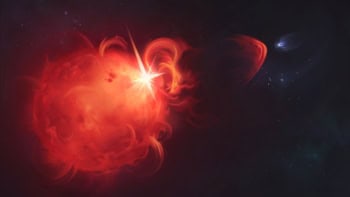Kate Gardner reviews The Beauty of Falling: a Life in Pursuit of Gravity by Claudia de Rham

Claudia de Rham decided early in life she wanted to be an astronaut. Her peripatetic childhood meant she spoke several languages, but imperfectly, and was drawn to science as a universal language – a more reliable base from which to understand the world. As her ambition to go into space developed, she learned to scuba dive and to fly planes, having heard these are desirable skills for astronauts.
Years of intense training appeared to pay off when, in 2009, de Rham made it to the final round of astronaut selection for the European Space Agency. In the end, she passed every test except the medical screening, which picked up latent tuberculosis – ruling her out not only in 2009 but forever. Thankfully, de Rham had also been pursuing a career in theoretical physics. So when her astronaut dream evaporated, she threw herself into the hardest challenge she’d ever experienced: understanding gravity.
Her new book The Beauty of Falling: a Life in Pursuit of Gravity is by no means an autobiography wrapped up in popular science, but it does use snippets from de Rham’s life story to explore the science of gravity. Sometimes the connection is straightforward: learning to dive and to fly provides some great visuals for explaining the basics of gravity and its interaction with other major forces. Other parallels are less obvious. Having moved around a lot as a child and as a researcher, de Rham likens the shape of her itinerant life to the curved nature of space–time. The metaphor works; perhaps better than the more standard one of a ball on a trampoline.
Unlike many popular-physics books, de Rham doesn’t linger too long on the history of human understanding of her topic. Three chapters suffice to bring us up to gravitational waves (or “glight” as she prefers to call it) and how we detect them. She then describes how observations of gravity break the rules of general relativity and the various theories of gravity that might be the next step in understanding.
This is where we reach de Rham’s own research on massive gravity, for which she and collaborators have won several prizes and grants. They argue that gravity, like electromagnetism, is both a particle and a wave. And, crucially, that a particle with non-zero mass – the graviton – exists. Its mass would have to be minuscule, of course – they postulate less than 10–30 eV. Gravitons would therefore be difficult – if not impossible – to find. But if they exist, gravitons would resolve some pesky problems in physics.
The book deals with some hugely complex theoretical ideas. Towards the end, even de Rham’s genius for metaphor just can’t keep up and she has to present the actual mathematics. As she says at that point, if a reader has stuck with her this far, they won’t be afraid of a few equations. It’s a reasonable assessment, because The Beauty of Falling is not a light read. While every step is clearly explained, the information is packed deep, tight and dense.

Claudia de Rham: a life in gravity
This density may well put off some lay readers, which is a shame, as de Rham is clearly capable of making complex ideas accessible individually. But I got the feeling that the density is intentional, as if de Rham has a point to prove about herself and her capabilities.
Though it isn’t a major theme even in the short biographical sections of the book, de Rham is of course a woman working in a male-dominated field, with theoretical physics being particularly short of women. It’s shocking to hear there were times in her education when de Rham, despite only being in her 40s, was the only woman in the room and that she was explicitly told women couldn’t understand advanced physics. She also struggled for years longer than male colleagues (including her own husband) to find a permanent position.
Thankfully she found a stable home at Imperial College, London, in 2016, where she’s been based ever since. Though she has wound up working on an idea that has been dismissed and even ridiculed by some, it’s clear that de Rham is not deliberately courting controversy; she loves her research. She finds massive gravity compelling and hopes that one day there will be a way to test it experimentally.
The Beauty of Falling is a reminder that the human side of science also includes the formulation of high-level abstract concepts – it’s in our nature to understand beyond what we can observe. Not every reader will follow the minutiae of massive gravity, but we can all empathize with the desire to comprehend it.
- 2024 Princeton University Press 232pp £20hb
- Physics World‘s Matin Durrani interviewed Claudia de Rham about this book and her career. Read the interview here



